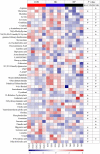Mucosal Microbiota and Metabolome in the Ileum of Hu Sheep Offered a Low-Grain, Pelleted or Non-pelleted High-Grain Diet
- PMID: 34512596
- PMCID: PMC8427290
- DOI: 10.3389/fmicb.2021.718884
Mucosal Microbiota and Metabolome in the Ileum of Hu Sheep Offered a Low-Grain, Pelleted or Non-pelleted High-Grain Diet
Abstract
Alterations in mucosal microbiota and metabolites are critical to intestinal homeostasis and host health. This study used a combination of 16S rRNA gene sequencing and liquid chromatography-mass spectrometry (LC/MS) to investigate mucosal microbiota and their metabolic profiles in the ileum of Hu sheep fed different diets. Here, we randomly allocated 15 Hu sheep to three diets, a non-pelleted low-grain diet (control diet; CON), a non-pelleted high-grain diet (HG), and a pelleted high-grain diet (HP). After 60 days of treatment, ileal mucosal samples were collected for microbiome and metabolome analysis. The results of principal coordinate analysis and permutation multivariate analysis showed that there was a tendency for microbial differentiation between the CON and HG groups (P < 0.1), although no significant difference between the HG and HP groups was observed (P > 0.05). Compared with the CON diet, the HG diet decreased (P < 0.05) the abundance of some probiotic species (e.g., Sphingomonas and Candidatus Arthromitus) and increased (P < 0.05) the abundance of acid-producing microbiota (e.g., Succiniclasticum, Nesterenkonia, and Alloprevotella) in the ileal mucosa. Compared with the HG diet, the HP diet decreased (P < 0.05) the abundance of Alloprevotella and increased (P < 0.05) the abundance of Mycoplasma in the ileal mucosa. Furthermore, partial least squares discriminant analysis and orthogonal partial least-squared discriminant analysis indicated that different dietary treatments resulted in different metabolic patterns in the ileal mucosa of the CON, HG, and HP groups. The HG diet altered (VIP > 1 and P < 0.05) the metabolic patterns of amino acids, fatty acids, and nucleotides/nucleosides (such as increased amounts of ornithine, tyrosine, cis-9-palmitoleic acid, and adenosine) compared with the CON diet. However, 10 differential metabolites (VIP > 1 and P < 0.05; including tyrosine, ornithine, and cis-9-palmitoleic acid) identified in the HG group exhibited a diametrically opposite trend in the HP group, suggesting that the HP diet could partially eliminate the changes brought upon by the HG diet. Collectively, our findings demonstrate that different diets altered the ileal mucosal microbiota and metabolites and provide new insight into the effects of high-grain diets on the intestinal health of ruminant animals.
Keywords: Hu sheep; high-grain diet; ileal mucosa; metabolome; microbiota; probiotics.
Copyright © 2021 Zhang, Zhong, Ma, Lin, Xie, Mao, Irwin, Wang and Zhang.
Conflict of interest statement
The authors declare that the research was conducted in the absence of any commercial or financial relationships that could be construed as a potential conflict of interest.
Figures






Similar articles
-
Comparison of the fermentation and bacterial community in the colon of Hu sheep fed a low-grain, non-pelleted, or pelleted high-grain diet.Appl Microbiol Biotechnol. 2021 Mar;105(5):2071-2080. doi: 10.1007/s00253-021-11158-5. Epub 2021 Feb 9. Appl Microbiol Biotechnol. 2021. PMID: 33559720
-
Differential Responses of Digesta- and Mucosa-Associated Jejunal Microbiota of Hu Sheep to Pelleted and Non-Pelleted High-Grain Diets.Animals (Basel). 2022 Jun 30;12(13):1695. doi: 10.3390/ani12131695. Animals (Basel). 2022. PMID: 35804593 Free PMC article.
-
Transcriptome analysis reveals the effect of high-grain pelleted and non-pelleted diets on ruminal epithelium of Hu-lamb.Animal. 2021 Jul;15(7):100278. doi: 10.1016/j.animal.2021.100278. Epub 2021 Jun 11. Animal. 2021. PMID: 34126388
-
A High Grain Diet Dynamically Shifted the Composition of Mucosa-Associated Microbiota and Induced Mucosal Injuries in the Colon of Sheep.Front Microbiol. 2017 Oct 26;8:2080. doi: 10.3389/fmicb.2017.02080. eCollection 2017. Front Microbiol. 2017. PMID: 29123511 Free PMC article.
-
Linkages between Epithelial Microbiota and Host Transcriptome in the Ileum during High-Grain Challenges: Implications for Gut Homeostasis in Goats.J Agric Food Chem. 2019 Jan 9;67(1):551-561. doi: 10.1021/acs.jafc.8b05591. Epub 2018 Dec 20. J Agric Food Chem. 2019. PMID: 30520636
Cited by
-
Dietary Palygorskite-Based Antibacterial Agent Supplementation as an Alternative to Antibiotics Improves Growth Performance, Blood Parameters, and Rumen Microbiota in Sheep.Antibiotics (Basel). 2023 Jul 2;12(7):1144. doi: 10.3390/antibiotics12071144. Antibiotics (Basel). 2023. PMID: 37508240 Free PMC article.
-
Differential responses of rumen and fecal fermentation and microbiota of Liaoning cashmere goats after 2-hydroxy-4-(methylthio) butanoic acid isopropyl ester supplementation.Sci Rep. 2024 Apr 12;14(1):8505. doi: 10.1038/s41598-024-58581-y. Sci Rep. 2024. PMID: 38605045 Free PMC article.
-
Dietary Administration of L-Carnitine During the Fattening Period of Early Feed Restricted Lambs Modifies Ruminal Fermentation but Does Not Improve Feed Efficiency.Front Physiol. 2022 Feb 24;13:840065. doi: 10.3389/fphys.2022.840065. eCollection 2022. Front Physiol. 2022. PMID: 35309073 Free PMC article.
-
Invasive Fascioloides magna infections impact gut microbiota in a definitive host in Europe.Int J Parasitol Parasites Wildl. 2024 Nov 25;25:101024. doi: 10.1016/j.ijppaw.2024.101024. eCollection 2024 Dec. Int J Parasitol Parasites Wildl. 2024. PMID: 39687766 Free PMC article.
-
Integrated rumen microbiome and serum metabolome analysis responses to feed type that contribution to meat quality in lambs.Anim Microbiome. 2023 Dec 19;5(1):65. doi: 10.1186/s42523-023-00288-y. Anim Microbiome. 2023. PMID: 38115081 Free PMC article.
References
LinkOut - more resources
Full Text Sources
Research Materials
Miscellaneous

